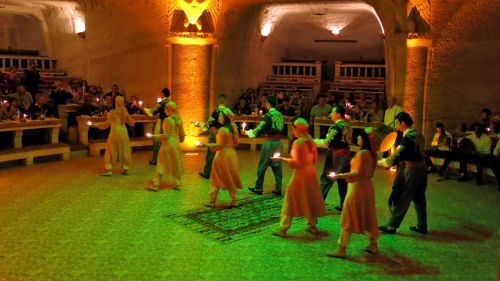PROPS IN BELLY DANCE: THEIR HISTORY AND CULTURAL ORIGINS
The use of props in belly dance is almost exclusively an American Cabaret phenomenon. The American Cabaret evolved throughout the early to mid-19th century, (1950's-1970's). Dancers were scarce and in high demand. They didn’t have the same cultural roots as their Middle Eastern counter-parts and their approach to the art was like any other artists in the west – make it as exciting and entertaining as possible. They were Borg’s; that is to say, they incorporated everything but the kitchen sink to make it appealing to western tastes. Sword dancing, candle dances, stick dances, basket dance, snake dances, all found their way into the American Cabaret dance, making this genre the first fusion style of belly dance.
THE CANDLE DANCE
One of the earliest pioneers of prop dancing was Serena Wilson, one of NYC’s premier dancers. She incorporated candles in her floor work. Today, fire dances are still done with a variety of fire devices. The origin of the Candle Dance is Turkish wedding procession dance.

Turkish Folk Dance Ensemble performing the Candle Dance in the famous cave restaurant in Cappadocia.

One of NYC's premiere dancers, Serena, pioneered the candle dance.
VEIL
Veil has been used in belly dance in Egypt, Greece and Turkey but minimally. Often used as a drape or costume piece, rather than a prop to dance with.

Princess Banu, one of Turkey's stars, reclined on her veil.

Egypt's Super-Star, Samia Gamal, twirling her veil.
It was in the USA that the veil became a dance unto itself, with an entire body of technique and vocabulary developed by American Cabaret dancers, such as Anaheed Sofian, Diane Webber and Aisha Ali.

LA based dancer, Diane Webber.

Chicago's super-star dancer, Dahlena.

NYC's super-star of American Cabaret, Anaheed Sofian.
EGYPTIAN SHAMADAN, (CANDELABRA) DANCE
Egypt is the only country in the Middle East that features props in belly dance including Shamadan, Raks Assaya (Taktib and Cane) and Raks al Balas (jug dance).

JUG/POT DANCES
The Pot Dance reflects the everyday life of women in the middle East. In the American Cabaret, it was just another opportunity to balance something and have fun showing off one's balancing skills

Tunisian Pot Dance

Uzbek Jug Dance

Raks al Balas - Egyptian pot dance.
.

Attan: A pot dance which is the national dance of Afghanistan.

Young belly dancers performing a Pot Dance.
THE SWORD DANCE
There are many places in the Middle East where a sword dance appears. In Morocco, Raks Assef is a duet done by the Tuaregs (“The Blue People”) of the Sahara. In Saudi Arabia, Raks al Ardha is a popular and exciting men’s sword dance.
In Iraq there is a courtship sword dance between a man and a woman in which the woman brandishes a sword and is chased by the man who is kept at a distance with the sword as he attempts to win or dominate her, signifying a balance of powers between the two in life, love and the home.

Tuareg Sword Dancers

Raks al Ardah - Saudi Sword Dance

Jean-Leon Gerome: Sword Dance in a Cafe.
There are no known traditional sword dances performed by women in the Middle East, however, there are paintings by European artists depicting women (belly dancers) dancing with [a sword] on their heads. American dancers adopted the sword as a regular prop in their cabaret suite as well as a specialty dance performed alone.

1970 American Cabaret Dancers dancing with Sword.
BASKET DANCE
The Basket Dance is a Central Asian harvest dance, adopted by American Cabaret dancers as a specialty dance. Tribal and cabaret dancers use baskets today in their dances.

Central Asian Harvest (Basket) Dance

Tribal Dancers
THE SNAKE DANCE
Many cultures have snake dances, but, the closest thing I have seen in the Middle East to a Snake Dance was a video clip of a dancer in Uzbekistan who did a Snake Dance. However, in the 1970’s American Cabaret dancers danced with snakes frequently.


1970's Cabaret dancers with Snake
THE SCARF DANCE
Scarf Dances entered the belly dance world as a costume part rather than a dance. Dancers stuffed
their belts with Scarves to enhance their hip movements, and occasionally danced with scarves as
part of the multiple veil dance.

Qashqai (Persian) Scarf Dancers
One of the best things about being a belly dancer in a culture from which it is not indigenous, is the freedom to expand and diversify with the art and make it more and more interesting with every additional prop. This freedom has allowed us to take the dance from a form of entertainment, to an extraordinarily diverse art.


















